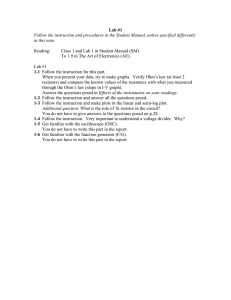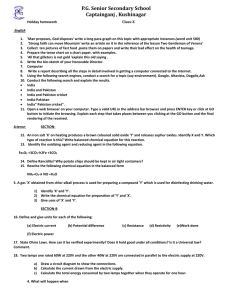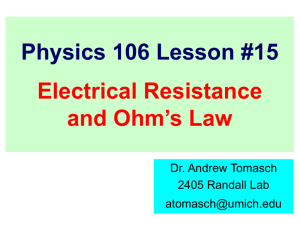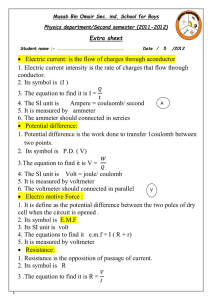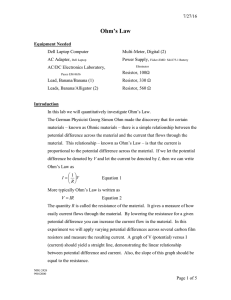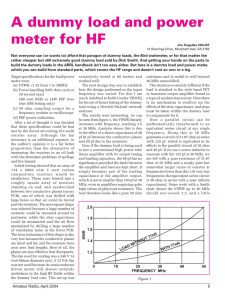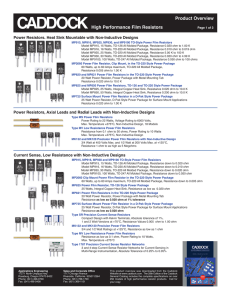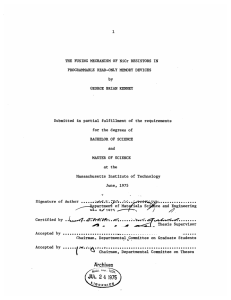Chapter 17 Problem 1
advertisement
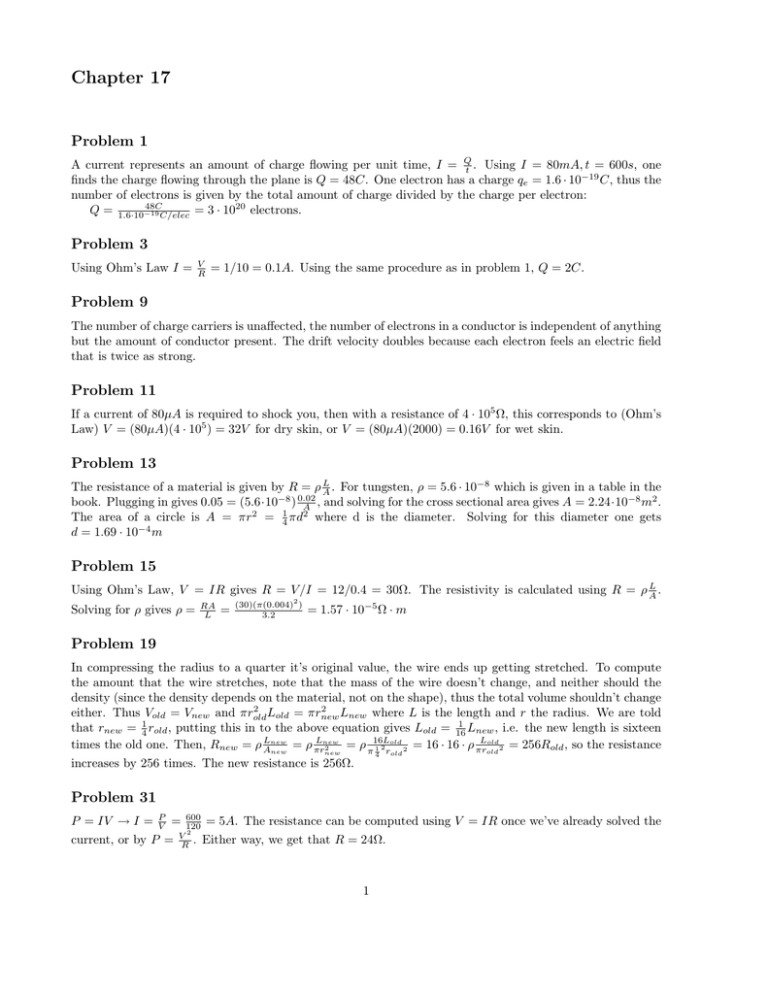
Chapter 17 Problem 1 A current represents an amount of charge flowing per unit time, I = Qt . Using I = 80mA, t = 600s, one finds the charge flowing through the plane is Q = 48C. One electron has a charge qe = 1.6 · 10−19 C, thus the number of electrons is given by the total amount of charge divided by the charge per electron: 48C 20 Q = 1.6·10−19 electrons. C/elec = 3 · 10 Problem 3 Using Ohm’s Law I = V R = 1/10 = 0.1A. Using the same procedure as in problem 1, Q = 2C. Problem 9 The number of charge carriers is unaffected, the number of electrons in a conductor is independent of anything but the amount of conductor present. The drift velocity doubles because each electron feels an electric field that is twice as strong. Problem 11 If a current of 80µA is required to shock you, then with a resistance of 4 · 105 Ω, this corresponds to (Ohm’s Law) V = (80µA)(4 · 105 ) = 32V for dry skin, or V = (80µA)(2000) = 0.16V for wet skin. Problem 13 L . For tungsten, ρ = 5.6 · 10−8 which is given in a table in the The resistance of a material is given by R = ρ A −8 0.02 book. Plugging in gives 0.05 = (5.6·10 ) A , and solving for the cross sectional area gives A = 2.24·10−8 m2 . The area of a circle is A = πr2 = 14 πd2 where d is the diameter. Solving for this diameter one gets d = 1.69 · 10−4 m Problem 15 L Using Ohm’s Law, V = IR gives R = V /I = 12/0.4 = 30Ω. The resistivity is calculated using R = ρ A . Solving for ρ gives ρ = RA L = (30)(π(0.004)2 ) 3.2 = 1.57 · 10−5 Ω · m Problem 19 In compressing the radius to a quarter it’s original value, the wire ends up getting stretched. To compute the amount that the wire stretches, note that the mass of the wire doesn’t change, and neither should the density (since the density depends on the material, not on the shape), thus the total volume shouldn’t change 2 2 either. Thus Vold = Vnew and πrold Lold = πrnew Lnew where L is the length and r the radius. We are told 1 1 Lnew , i.e. the new length is sixteen that rnew = 4 rold , putting this in to the above equation gives Lold = 16 Lold 16Lold Lnew Lnew times the old one. Then, Rnew = ρ Anew = ρ πr2 = ρ π 1 2 r 2 = 16 · 16 · ρ πr 2 = 256Rold , so the resistance old new 4 old increases by 256 times. The new resistance is 256Ω. Problem 31 P = IV → I = VP = 600 120 = 5A. The resistance can be computed using V = IR once we’ve already solved the V2 current, or by P = R . Either way, we get that R = 24Ω. 1 Chapter 18 Problem 5 Add the two parallel resistors first to get R = 4.12Ω. Then add the remaining three resistors in series to get Rtotal = 17.12Ω. The total current in the circuit is then given by Ohm’s Law, and is 1.98A. The 4Ω and 9Ω resistors have the same current, since they are in series (much like capacitors in series have the same charge), so they both have a current of 1.98A in them. The two resistors in parallel have the same voltage (again, compare to capacitors), but this voltage is NOT 34V. This is because some of the voltage is lost in the 4 and 9 ohm resistors. The voltage drop over the 9Ω resistor is V = 1.98 ∗ 9 = 17.82V , and in the 4Ω resistor is V = 1.98 ∗ 4 = 7.92V , which leaves 8.26V for the parallel resistors. Thus, the current in the top resistor V 8.26 is I = VR = 8.26 7 = 1.18A and in the bottom resistor we have I = R = 10 = 0.826A. These two currents add up to 1.98, as required by conservation of charge and current (there is some slight rounding error in my calculation). Problem 7 Start from the very right, and add the two parallel resistors. They combine to form an equivalent resistance of R/2. Add that in series with it’s neighbor to get 3R/2. The resistor that is left free contributes nothing to the resistance because electricity can’t flow there. This is because there is nowhere for the electricity to go if it went that way, thus we can ignore that resistor. The last resistor on the left adds in series with the others we added, combining for a total of 5R/2Ω = 2.5RΩ. Problem 17 & 21 are solved in the HW 3 Circuits file 2

